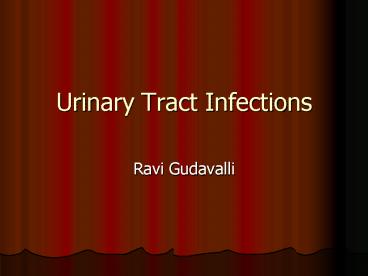Urinary Tract Infections - PowerPoint PPT Presentation
1 / 30
Title:
Urinary Tract Infections
Description:
Kidney : Acute Pyelonephritis, abscess. UTI's. Asymptomatic Bacturia ... Reasonable regimens: Amoxicillin, Nitrofurantoin, Cephalexin. ... – PowerPoint PPT presentation
Number of Views:1641
Avg rating:3.0/5.0
Title: Urinary Tract Infections
1
Urinary Tract Infections
- Ravi Gudavalli
2
Anatomy
- Lower urinary tract ( superficial )
- Urethra
- Bladder
- Upper urinary tract ( tissue invasion)
- Prostate
- Kidney Acute Pyelonephritis, abscess
3
UTIs
- Asymptomatic Bacturia
- Uncomplicated/Complicated Cystitis
- Acute/Chronic Prostatitis
- Uncomplicated/Complicated Pyelo
- Intrarenal and Perinephric Abscesses
- Nosocomial vs. Community-Acquired
4
Epidemiology
- Catheter associated ( nosocomial)
- Non-catheter associated (community acquired)
- Young sexually active women
5
- Where are the bugs coming from ????
6
Etiology/Microbiology
- Gram ve rods
- _____________ 70-95 of episodes.
- Staphylococcus saprophyticus most of remainder.
- Proteus, Klebsiella ( stones) , enterococci,
Serratia, Pseudomonas ( instrumentation)
7
- Dont forget Chlamydia, Niesseria, Herpes
simplex ( urethritis ) in young sexually active
patients with sterile pyuria
8
- Why does voiding after sexual intercourse reduce
incidence of UTIs ??
9
Pathogenesis
- Normal flora
- Altered flora
- Females with short urethra (4 cm), proximity of
the urethra to the anus - Use of spermicidal agents (change in flora)
- Males more than 50 BPH Obstruction
10
- Pregnancy decreased ureteral tone, peristalsis,
increased vesicoureteral reflux - Obstruction tumor, stricture, stone, BPH
- ( important to recognize any obstruction as
this can cause rapid destruction of tissue when
complicated with infection) - Neurogenic bladder
- Vesico-ureteral reflux
11
- Virulence factors
- Uropathogenic strains
- P-factor
12
UTIs Risk Factors
- Sexual Intercourse esp. with spermicide
- MSM - unprotected
- Lack of Circumcision
- AIDS and CD4lt200
- Diabetes (only in females, not males)
- Post-menopausal State
- BPH
- Pregnancy (mostly for asxatic bacturia)
13
Risk Factors
- Anatomic abnormalities
- Vesicoureteral Reflux
- Ureteral Obstruction
- Foreign Body
- BPH
- Incomplete Bladder Emptying
- Instrumentation
14
- Signs and Symptoms
15
UTIs Signs and Symptoms
- Dysuria, Frequency, Nocturia, Urgency,
Suprapubic/Back pain, Malodorous Urine,
Hematuria, Cloudy urine. - Pyelo Fever, Chills, Nausea, Vomiting, Loin
Pain, with or without above symptoms. CVA
tenderness, tachycardia. - Prostatitis Chills, dysuria, urgency, frequency,
perineal/back/pelvic pain. Prostate
tender/enlarged/indurated. Chronic is much more
occult.
16
UTIs - Urinalysis
- Growth of _____ organisms/ml from a clean catch
specimen. - 102 104 colonies significant with SP catheter
aspiration, straight cath, or typical symptoms. - Pyuria, Microscopic/Gross Hematuria, Bacteriuria,
WBC Casts. - Unspun midstream urine gt10 WBC/hpf considered
abnormal.
17
- Pyuria and Hematuria
18
- Dipstick UA
- Detect pyuria by _____________and
Enterobacteriaceae via____________. - Both fairly sensitive for high count UTIs, LE
better for intermediate (Bacteriuria lt105
colonies.)
19
UTIs What about Cultures?
- Urine cultures
- Not necessary in routine uncomplicated cystitis.
- Role of pre-treatment cultures currently being
evaluated because of emerging resistance among
uropathogens. - _____________ 15 50 y/o should have cultures.
20
UTIs Therapy
- Depends on clinical situation
- Male vs. Female
- Young vs. Old
- Catheter-associated or not
- Hx of recurrent infections or not
- Lower vs. Upper Urinary Tract
21
Acute Cystitis
- Usually a ________ regimen
- __________________________________________________
_________________________ are good choices
empirically. - One day regimens, even with the new drug
Fosfomycin, not as effective as 3 days of above
meds. - Nitrofurantoin not unreasonable, but is a 7-day
regimen. - Increased hydration may dilute the antibiotic so
is not recommended. - Cranberry juice IS an effective for prophylaxis,
but shows no benefit in treatment. - Phenazopyridine Pyridium.
- Culture IF symptoms fail to resolve.
22
UTIs - Therapy
- Recurrent Infection
- Counseling post-coital voiding, cranberry
juice, change BC from spermicide. - 3 or more episodes in one year
- ___________________
- ___________________
- ___________________
- Relapsing Infection
- Same strain Radiologic/Urologic Eval.
23
UTIs - Therapy
- Men with UTI
- NO short-course therapy.
- 7-14 days of Bactrim or a Quinolone.
- gt50, check the prostate.
- Acute prostatitis
- 4 wks Bactrim, 2 wks FQ.
- Recurrence treat 4 6 weeks. Recurrent
recurrence treat 12 weeks. - Rec. Rec. Recurrence? Tx again, Long-term
suppression, Prostatectomy
24
Acute cystitis in Pregnancy
- ____________ the Urine!
- Treat Asymptomatic Bacteriuria.
- Watch closely for pyelo Admit in this case.
- Treat for 3-7 days.
- Reasonable regimens Amoxicillin, Nitrofurantoin,
Cephalexin. - Also Augmentin, Bactrim (not 3rd trimester),
Cefpodoxime. - Not quinolones.
- _________________________ in one to two weeks.
25
UTIs - Therapy
- Post-menopausal Women Evaluate for need for
________________ preparations.
26
Complicated cystitis
- Resistant organisms
- Empirically quinolones, tailor to culture
result - Failure to respond clinically within 24 48
hours requires UT imaging and repeat cultures. - Duration usually 7 14 days.
27
- Acute Uncomplicated Pyelo
- Not too sick, No N/V
- Cipro/other FQ 7 days.
- Bactrim reasonable, too.
- Sicker, N/V
- Admit, IV AB AmpGent, IV Bactrim, FQ, 3rd Gen.
Cephalosporin. - D/C once afebrile for 24 hours.
- Switch to oral total of 14 days.
28
- Complicated UTI
- Treat only if symptomatic, unless preg.
- Sterilize urine if planning on instrumentation.
- Broad spectrum, and tailor to cultures.
- Try to correct underlying abnormality.
- X-ray evaluation
- IVP, Voiding cystourethrogram, Ultrasound,
Helical CT (with and without contrast
29
Catheter-associated
- 40 of nosocomial infections
- Prevention BIG TIME! (Proper technique,
isolation, closed system, etc.) - Symptomatic treat, change out catheter, and
culture. - Therapy for asymptomatic patients just selects
for resistant organisms, so just watch and hope
for the best.
30
(No Transcript)































